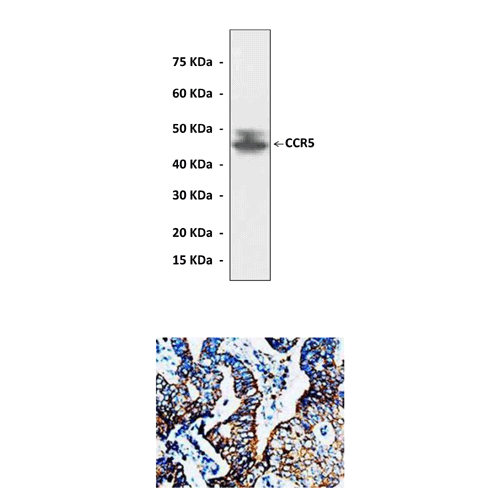Anti-CCR5: Polyclonal C-C Chemokine receptor 5 Antibody |
 |
BACKGROUND Chemokines (chemotactic cytokines) belong to a family of chemoattractant molecules involved in the directed migration of immune cells. Over fifty human chemokines have been identified that can be categorised into four groups; CC, CXC, CX3C and C (XCL1 and XCL2); depending on the spacing of their first two cysteine residues. Chemokines exert their effects by binding to G-protein-coupled chemokine receptors on the surface of cells, predominantly leukocytes. Eighteen human chemokine receptors have been identified that are classified according to the class of chemokines that they bind.1 The major function of chemokines is to regulate leukocyte trafficking in hematopoiesis and in innate and adaptive immunity. Other functions include angiogenic activity, apoptosis, T-cell differentiation and phagocyte activation. Inadvertent activation of chemokine receptors leads to autoimmunity by inappropriately targeting self-antigens for destruction by cytotoxic T-cells and macrophages.2
CCR5 is a member of the beta chemokine receptor family, which is predicted to be a seven transmembrane protein similar to G protein-coupled receptors. This protein is expressed by T cells and macrophages, and is known to be an important co-receptor for macrophage-tropic virus, including HIV, to enter host cells. Defective alleles of this gene have been associated with the HIV infection resistance.3 The ligands of this receptor include a number of inflammatory CC-chemokines including MIP-1-alpha, MIP-1-beta and RANTES and it subsequently transduces a signal by increasing the intracellular calcium ion level. Expression of this gene was also detected in a promyeloblastic cell line, suggesting that this protein may play a role in granulocyte lineage proliferation and differentiation.4 This gene is located at the chemokine receptor gene cluster region. Two transcript variants encoding the same protein have been found for this gene.
CCR5 is a member of the beta chemokine receptor family, which is predicted to be a seven transmembrane protein similar to G protein-coupled receptors. This protein is expressed by T cells and macrophages, and is known to be an important co-receptor for macrophage-tropic virus, including HIV, to enter host cells. Defective alleles of this gene have been associated with the HIV infection resistance.3 The ligands of this receptor include a number of inflammatory CC-chemokines including MIP-1-alpha, MIP-1-beta and RANTES and it subsequently transduces a signal by increasing the intracellular calcium ion level. Expression of this gene was also detected in a promyeloblastic cell line, suggesting that this protein may play a role in granulocyte lineage proliferation and differentiation.4 This gene is located at the chemokine receptor gene cluster region. Two transcript variants encoding the same protein have been found for this gene.
REFERENCES
1. Zlotnik, A. & Yoshie, O.:Immunity 12:121-27, 2000
2. Locati, M.: Ann. Rev. Med. 50:425-40, 1999
3. Moore, J.P. et al: AIDS Res Hum. Retrovir. 20:111-126, 2004
4. Turner, J.E. et al: Mini Rev. Med. Chem. &;1089-96, 2007
2. Locati, M.: Ann. Rev. Med. 50:425-40, 1999
3. Moore, J.P. et al: AIDS Res Hum. Retrovir. 20:111-126, 2004
4. Turner, J.E. et al: Mini Rev. Med. Chem. &;1089-96, 2007
Products are for research use only. They are not intended for human, animal, or diagnostic applications.
Параметры
Cat.No.: | CA0707 |
Antigen: | N-terminal sequence of human CCR5 |
Isotype: | Affinity-Purified Rabbit Polyclonal IgG |
Species & predicted species cross- reactivity ( ): | Human, Rabbit, Rat, Mouse |
Applications & Suggested starting dilutions: | WB 1:500 to 1:1000 IP n/d IHC (Paraffin) 1:50 to 1:200 ICC n/d FACS n/d |
Predicted Molecular Weight of protein: | 40 - 60 kDa |
Specificity/Sensitivity: | Anti-CCR5 reacts specifically with CCR5 of human, mouse & rat origin in immunostaining and western blotting, no cross-reactivity with other members of the family. |
Storage: | Store at 4° C for frequent use; at -20° C for at least one year. |
*Optimal working dilutions must be determined by end user.
Документы
Информация представлена исключительно в ознакомительных целях и ни при каких условиях не является публичной офертой








